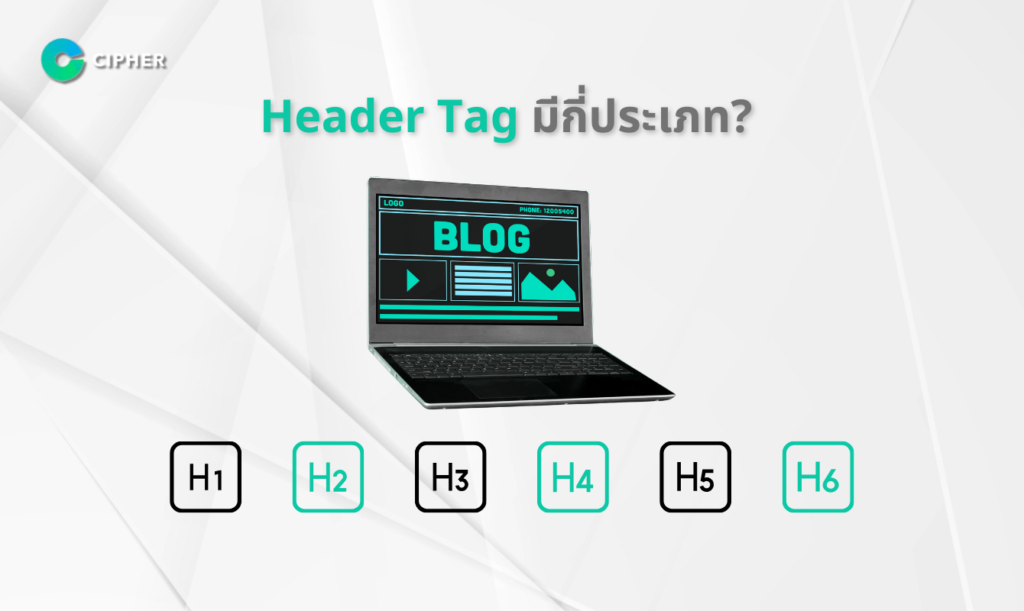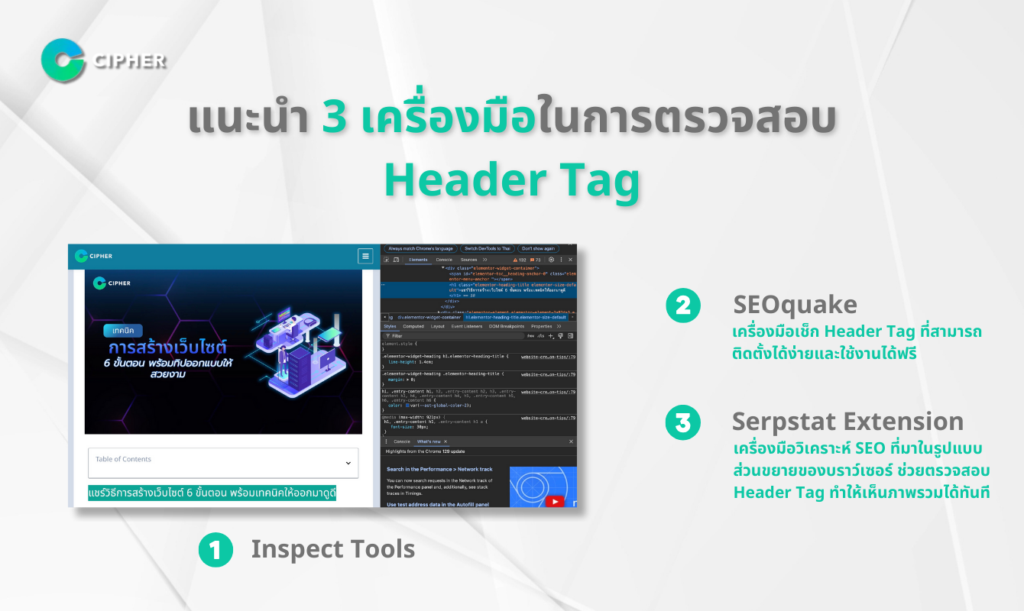Table of Contents
What is a Header Tag? How to Use It? Why is it Important for SEO?
Effective content marketing not only creates interesting content but also focuses on the technical elements that help the website rank on the Search Engine. Whether it’s meta tags to create a header, Meta Title or Meta Description is an important part of SEO that helps explain the content of the page to users and Search Engine quickly understand.
If you’re looking for ways to top the list on Google, this article will help you get to know the Header Tag. Whether you’re a website owner, marketer, or SEO enthusiast, it will help you understand the importance and effectiveness of using the Header Tag.
What is a Header Tag?

Header or Heading is a content header used to prioritize text on a website. It is generally larger than normal content to attract attention and help readers understand the structure of the content. It is an HTML component that defines the page header from H1 to H6, with H1 being the most important and the largest. H6 be of the least importance and the smallest size
Proper use of Header and Heading not only helps organize content for readability, but also makes SEO a search engine optimization because search engines use Header tags to understand the structure and importance of page content. Correctly in order, it will help the website to be ranked better in search rankings.
Why is Header Tag important to SEO?
Header Tag is an HTML code, or Meta Tags, used to prioritize content on a webpage, from H1 to H6, which is very important to SEO as Google and other Search Engines use Header Tags to indicate the structure and priorities of content. It will help the system understand which part of the content is most important and how the rating should be weighed.
Good Meta Tags like Heading Tags also play an important role in improving the user experience as they systematically divide content into segments, making it easier and faster for readers to scan content. These factors also affect the ranking in Search Results.
What is the type of Header Tag? Any?

When it comes to Heading Tag SEO, tags are divided into six categories, from H1 to H6, all tags are used to identify page names or articles on that page. What each Heading Tag is important for the SEO as follows:
H1 is... What, why the Header Tag is the most important?
Header Tag or H1 is one of the components used to determine the structure and priorities of content on the website or highlight the Landing Page. The most important thing is that H1 is the Header Tag.
- Highest Read Priority: The Search Engine gives H1 the most weight to understand the content of a page. It is the main title that indicates that all content is about. What?
- Impact on SEO: Using a relevant H1 with appropriate keywords increases the likelihood of ranking search results as it is an important factor Google uses to evaluate the relevance of content.
- Importance to User Experience: H1 helps readers immediately understand what content is about to be read. What affects your decision on whether to continue reading the content or not, and helps you to scan for the information you need more quickly?
What is H2 (Heading 2)?
H2 or Heading 2 is one of the key components of website content structure. It serves as a secondary topic to H1 (Heading 1) in the content management hierarchy. The main function and highlight of H2 are:
- Prioritization: H2 allows the reader to systematically divide the content into parts, allowing them to quickly and efficiently understand the structure of the content, especially in long and complex articles.
- SSEO Benefits:earch engines pay particular attention to the content under the H2 tag, as it often indicates the importance of the content, giving websites a better chance of ranking themselves on the search list.
- Ease of Reading: Using H2 creates a resting point and makes the content more readable. Readers can easily sweep their eyes for the information they want without reading the entire content.
What is H3 (Heading 3)?
H3 or Heading 3 is one of the topic levels used to organize content on websites and digital documents. It is the third sub-item following H2, whose main responsibilities are:
- Content sorting: H3 plays an important role in creating a content hierarchy by helping organize information into clear subcategories, allowing readers to quickly understand the content.
- Improved Heading Tag SEO: Proper use of H3 improves SEO performance as it is one of the factors that search engines use to evaluate the importance of content and rank search results.
- Save time for users: H3 is very useful for users because it makes it easier for them to find the content they want to read.
What is H4 (Heading 4) – H6 (Heading 6)?
H4, H5 and H6 are the levels of topics for formatting important websites, second to H3, down to the smallest of them. Using these topics appropriately not only provides a clear structure of documentation, but is also very useful for SEO. This is because search engines use these subject levels to understand the importance and relationships of content within a page.
For example, how about placing the correct Header Tag 1-3?
For example, the article “Content Marketing is What?”
- H1: What is Content Marketing? And Why is it Important for Digital Businesses?
- H2: Meaning and importance of Content Marketing
- H2: Format of Content Marketing
- H3: B2C Content Marketing
- H3: B2B Content Marketing
- H2: Effective Content Marketing Strategy
Header Tags Ordering in This Article
- Using H1 as the main article title “What is Content Marketing? And Why is it Important for Digital Businesses?” There is only one H1 per page, covering the entire content of the article.
- Using H2 to divide the content into 3 main sections.
- Using H3 to separate sub-headings under each main section.
The advantage of this layout is that the article has a clear hierarchy, not confusing. The content is related in order, making it easy to read and understand. It is suitable for SEO and creates a good reading experience for readers.
Introducing 3 tools to check Header Tag

Checking the Header Tag structure is one of the important steps in SEO to make the website have a clear content hierarchy that is useful for both users and search engines. Using the right tools will help check and adjust Header Tag more effectively.
1. Inspect Tools
The basic tool that comes with every web browser allows you to check HTML and Header Tag structure. Simply right-click on the web page and select “Inspect” or press F12, then select the code or find code. Put the mouse on the topic. Inspection Tools has the feature of viewing HTML code in real-time and editing tests immediately. Ideal for website developers who need resolution to check.
2. SEOquake
The Header Tag check tool is easy to install and free to use. It is an extension of Chrome, which can be easily checked because the tool summarizes various Header Tag items on one page.
3. Serpstat Extension
The browser extension-based SEO analysis tool provides a quick overview of the Header Tag. It is characterized by a comparative analysis, a large database that helps analyze competitors and provides practical advice on improving the site’s Header Tag.
Conclusion
Using the Header Tag correctly and effectively is one of the key strategies to help your website better rank on Google. Through CIPHER’s SEO experience, good meta tags, especially Meta Title and Meta Description, can help increase click rate (CTR) to the website. This will also benefit the ranking of websites as well.
If you are looking for SEO professionals who understand SEO techniques and strategies, CIPHER will help your website reach the top of Google’s list with a team of experienced professionals. Contact us today to consult and plan an SEO strategy that suits your business.
Frequently Asked Questions
What is H1 H2 H3?
Heading is an important part of organizing the content structure of a website. It is divided into H1, H2 and H3 in order as follows:
- H1 is the most important and largest main heading. It is often used as the title or main topic of a web page.
- H2 is a sub-heading that divides the content into sections, helping readers understand the structure of the content more easily.
- H3 is a sub-heading under H2, used to divide the content into more details.
Heading order is not only what makes the content easy to read, but it is also important for SEO because it helps search engines understand the structure and importance of the content on the web page better.
What's H1?
H1 or Heading 1 is an HTML tag used to define the main topic of a page. It is important to prioritize content and make SEOs because H1 has to address the main points of that page and should have only one H1 tag per page so that both the reader and the Search Engine can understand the content structure clearly. As a result, the website will be able to rank better in the search results.
How many levels is Tag H?
Tag H has a total of 6 levels, each with reduced importance as follows:
- H1 (Heading 1): It’s the most important topic of a page. There should be only one H1 per page in order to comply with SEO principles and prioritize content. It’s like the title of the article or the page.
- H2 (Heading 2): Used to divide content into parts or sub-topics under H1, it helps readers and search engines better understand the structure of content. There can be several H2s in one page, as appropriate.
- H3 (Heading 3): A sub-item under H2 is used to divide the content in more detail. It is suitable for explaining the sub-items or specific details of the H2 sub-item.
- H4 (Heading 4): Used for subtopics under H3 to divide the content in more detail, suitable for presenting information that requires higher resolution.
- H5 (Heading 5): Used for sub-items from H4 to divide the resolution of the content more is used less than other topics.
- H6 (Heading 6) is the smallest topic level. Used in cases where you want to divide the content into extra detail. It is suitable for organizing complex content.
HTML Tag used to define the subject has Anything?
HTML Tag is the creation of Heading with HTML code, with header tags that help systematically prioritize and hierarchy content on the website. It consists of 6 levels from <h1> To <h6> Which <h1> is the largest and is used for the main heading of the web page, while <h2> To <h6> They will be reduced in size respectively for use with various sub-topics.
Proper use of these topic tags not only provides a clear and easy-to-read structure for websites, but also is critical to SEO as search engines use them to understand the importance of page content.





